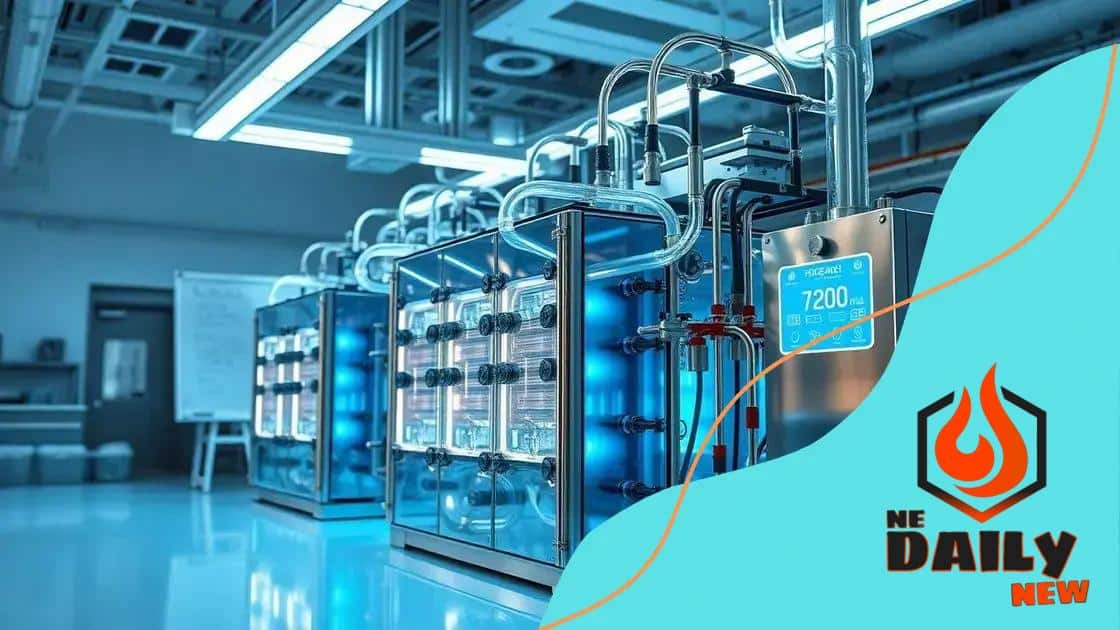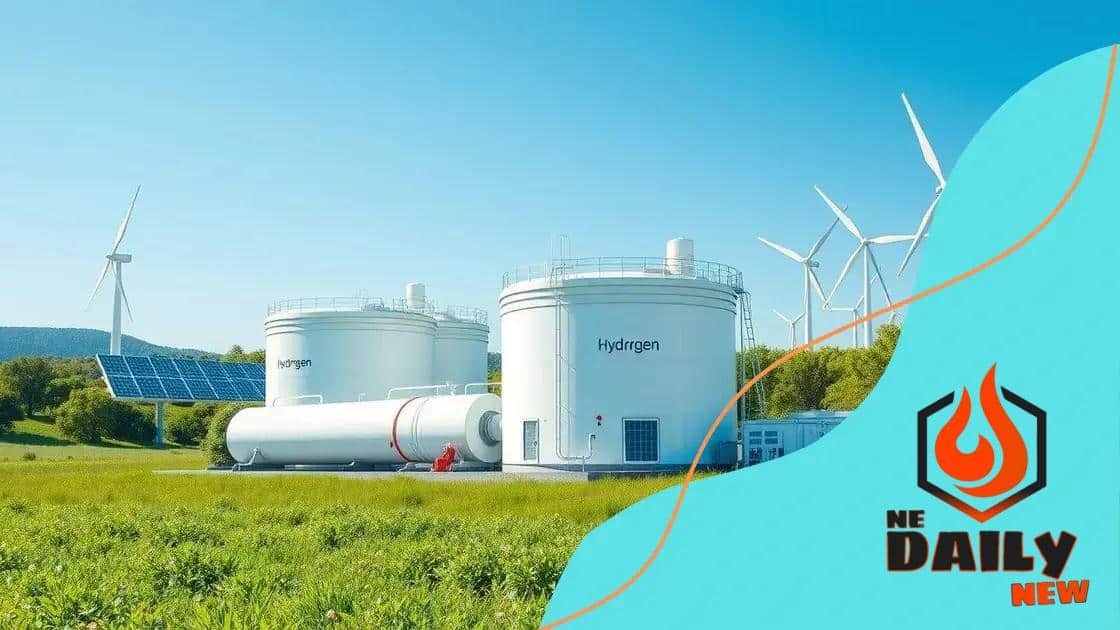Advances in clean hydrogen energy technologies

Advances in clean hydrogen energy technologies enhance production efficiency and sustainability, positioning hydrogen as a key component in the transition to a low-carbon energy future.
Advances in clean hydrogen energy technologies are paving the way for a sustainable future. Have you ever wondered how these innovations could change our energy consumption? In this article, we’ll explore their potential impact.
Understanding clean hydrogen energy technologies
Understanding clean hydrogen energy technologies is essential in today’s push for sustainable energy solutions. With climate change becoming a pressing issue, the need for clean alternatives is greater than ever.
One of the key advantages of using hydrogen energy is its versatility. Hydrogen can be produced from various sources, including water, natural gas, and biomass. Furthermore, it emits only water when burned, making it an eco-friendly choice.
How Hydrogen is Produced
There are several methods to produce hydrogen, and each has its unique advantages:
- Electrolysis: This process involves using electricity to split water into hydrogen and oxygen. Renewable energy sources, like solar or wind, can power this method.
- Steam methane reforming: A common industrial method that extracts hydrogen from natural gas, although it produces carbon emissions.
- Gasification: Here, organic materials are converted into hydrogen-rich gas, harnessing the potential of biomass.
- Thermochemical cycles: High-temperature processes that can produce hydrogen using solar energy.
The role of clean hydrogen in renewable energy systems is becoming increasingly important. It can serve as a storage medium for excess energy, allowing regions with high renewable output to balance supply and demand efficiently. Additionally, hydrogen can be used in fuel cells to generate electricity, powering vehicles and stationary applications.
Challenges to Adoption
Despite the advantages, there are challenges to widespread adoption. Infrastructure development for hydrogen storage and transport is critical. Currently, most systems are designed for traditional fuels, which complicates the integration of hydrogen. Additionally, production costs, especially for green hydrogen from renewable sources, remain a significant hurdle.
Investments in research and development are crucial for creating efficient, low-cost production methods. Public awareness and acceptance of hydrogen technologies will also help in overcoming initial hurdles. By educating communities about the benefits of clean hydrogen energy technologies, we can foster greater support for adoption.
As we explore these technologies further, it’s important to continue advocating for sustainable practices and innovations. The incorporation of clean hydrogen into our energy mix has the potential to reshape our reliance on fossil fuels, driving us closer to a greener, cleaner future.
Recent breakthroughs in hydrogen production
Recent breakthroughs in hydrogen production have captured the attention of scientists and industries alike. As we strive to reduce our carbon footprint, these advances offer exciting possibilities for cleaner energy.
One significant development is the improvement in electrolysis technology. This method, which splits water into hydrogen and oxygen using electricity, has become more efficient. Researchers are now using renewable energy sources to power electrolysis, making it a sustainable option for producing green hydrogen. This clean method helps reduce reliance on fossil fuels while minimizing environmental impact.
Advancements in Hydrogen Production Techniques
Let’s explore some of the key breakthroughs:
- High-Temperature Steam Electrolysis: By applying high temperatures, researchers have increased the efficiency of hydrogen generation. This method reduces energy consumption and enhances overall production.
- Photoelectrochemical Water Splitting: This innovative technique uses sunlight to drive the electrolysis process. Utilizing solar energy can significantly lower production costs and supports sustainability.
- Biomass Gasification: Recent technologies have improved the conversion of organic materials into hydrogen. This process allows waste materials to produce energy, promoting a circular economy.
- Membrane Technology: Advancements in membrane separation processes have also emerged. These membranes selectively filter hydrogen, increasing purity and yield during production.
These advancements are paving the way for more efficient and cost-effective methods of producing hydrogen. Other significant improvements include better catalysts that enhance reaction rates, leading to reduced operational costs. Researchers are working on finding alternatives to precious metals, exploring catalysts made from abundant materials.
Additionally, integrating hydrogen production with renewable energy sources, such as wind or solar, can help stabilize our energy systems. The combination of these resources has the potential to create a more reliable power supply while maintaining low emissions.
As these technologies continue to evolve and gather support, they promise to transform the future of energy. The potential of hydrogen production not only contributes to energy independence but also aligns with global sustainability goals.
The role of hydrogen in renewable energy systems

The role of hydrogen in renewable energy systems is becoming increasingly important as we transition to more sustainable energy sources. Hydrogen has the potential to be a vital component in creating a cleaner energy landscape.
Hydrogen acts as an energy carrier, which means it can store and transport energy generated by renewable sources. This characteristic is particularly valuable when energy production fluctuates, such as on cloudy or calm days. By storing excess energy from solar or wind farms as hydrogen, we can ensure a more reliable and stable energy supply.
How Hydrogen Integrates with Renewables
Integrating hydrogen into renewable systems involves several key processes:
- Energy Storage: Hydrogen can be produced when renewable energy is abundant. This stored hydrogen can then be converted back into electricity or used as fuel when needed.
- Fuel Cells: Hydrogen fuel cells convert hydrogen into electricity, providing a clean energy source for vehicles and buildings without harmful emissions.
- Grid Stabilization: Hydrogen can help balance supply and demand. During peak production, excess energy can generate hydrogen, helping to stabilize the grid.
- Decarbonizing Industries: Industries such as steel and cement can use hydrogen instead of fossil fuels, significantly reducing carbon emissions.
The versatility of hydrogen also makes it suitable for various applications. It can be used in transportation, powering vehicles through hydrogen fuel cells, or injected into natural gas pipelines to reduce the overall carbon intensity of gas. This flexibility allows industries to utilize existing infrastructure while transitioning to cleaner energy sources.
Moreover, the synergy between hydrogen and renewables can accelerate the development of a robust hydrogen economy. This would not only create jobs but also drive investments in clean technology. By prioritizing hydrogen, regions can leverage their renewable resources and create sustainable energy ecosystems, ultimately aiding global climate goals. The future of hydrogen in renewable energy systems looks promising, paving the way for a cleaner, more resilient energy future.
Challenges facing hydrogen adoption
Challenges facing hydrogen adoption are numerous and complex. As hydrogen technology progresses, it’s crucial to address these hurdles to fully realize its potential in our energy systems.
One significant challenge is the infrastructure needed for hydrogen production, storage, and distribution. Many regions still rely heavily on fossil fuels, making the transition more complicated. Establishing new pipelines and refueling stations demands substantial investment and planning, which can slow down the adoption process.
Key Challenges in Hydrogen Adoption
Here are some of the primary obstacles:
- Cost: The production of green hydrogen remains relatively expensive compared to fossil fuels. Developing cost-effective production methods is essential to make hydrogen competitive.
- Storage: Hydrogen storage poses technical challenges due to its low energy density. Efficient storage solutions must be developed to handle hydrogen safely and economically.
- Public Awareness: Many people are unaware of the benefits of hydrogen energy. Education and outreach are needed to inform the public and gain support for hydrogen initiatives.
- Regulatory Framework: The lack of a clear regulatory framework can hinder investment and development. Establishing guidelines and standards is critical for safety and efficiency.
Another significant challenge lies in the transition from conventional energy sources. As countries move toward cleaner energy, the existing industries that rely on oil and gas may resist this change. This resistance can slow the growth of hydrogen infrastructure.
Furthermore, technological advancements must keep pace with the growing demand for hydrogen. Innovations in production techniques, such as using renewable energy for electrolysis, need to be accelerated. Collaborations between governments, corporations, and research institutions can foster the development of new technologies and approaches.
Addressing these challenges requires a holistic approach. Governments must encourage investments in hydrogen technologies and infrastructure. Public-private partnerships can play a vital role in driving innovation and reducing costs. By tackling these obstacles, we can move closer to a future where hydrogen is a key player in the global energy landscape.
Future prospects for clean hydrogen energy
Future prospects for clean hydrogen energy are very promising as the world shifts toward sustainable energy solutions. As technology advances, hydrogen is set to play a crucial role in reducing carbon emissions and promoting energy independence.
One key aspect is the increasing investment in hydrogen technologies by governments and private sectors worldwide. Many countries are developing national hydrogen strategies to increase production and distribution. These strategies aim to leverage local resources, making hydrogen more accessible and affordable.
Emerging Technologies in Hydrogen Production
Innovative technologies are continuously being developed, enhancing hydrogen production efficiency. Some of these advancements include:
- Electrolysis improvements: New electrolyzers are being designed to operate more efficiently with renewable energy sources.
- Biomass conversion: Techniques that convert organic materials into hydrogen are gaining traction, making hydrogen production more sustainable.
- Carbon capture: Integrating carbon capture technology with hydrogen production helps mitigate overall emissions, enhancing sustainability.
Additionally, hydrogen as an energy carrier brings flexibility to the energy system. It can store excess energy generated during peak renewable production and release it when needed, ensuring a stable energy supply. This flexibility is essential for integrating various renewable energy sources into the grid.
Hydrogen in Various Sectors
Clean hydrogen energy is not limited to electricity generation. Its applications extend to several sectors:
- Transportation: Hydrogen fuel cells are being adopted for buses, trucks, and trains, providing a zero-emissions alternative to diesel engines.
- Heating: Hydrogen can be blended with natural gas for residential and commercial heating, reducing carbon footprints.
- Industry: Heavy industries, such as steel production, can shift from coal to hydrogen, significantly reducing emissions.
As infrastructure develops, the adoption rate of hydrogen technologies is expected to rise. Countries are building hydrogen refueling stations and expanding gas networks to accommodate this new form of energy. This shift will foster job creation and economic growth in regions focused on hydrogen initiatives.
Ultimately, the future of clean hydrogen energy hinges on collaborative efforts between governments, industries, and researchers. This partnership is crucial for overcoming current challenges and ensuring that hydrogen can fulfill its potential as a cornerstone of the new energy landscape.
clean hydrogen energy looks bright as technological advances and growing support pave the way for a sustainable energy landscape. Overcoming challenges such as infrastructure and cost is essential for widespread adoption. By investing in hydrogen technologies, we can create a cleaner, more efficient energy system that benefits both the environment and the economy. Collaboration among governments, industries, and communities will be crucial for unlocking hydrogen’s full potential. Together, we can harness the power of hydrogen to drive a greener future.
FAQ – Frequently Asked Questions about Clean Hydrogen Energy
What is clean hydrogen energy?
Clean hydrogen energy refers to hydrogen produced with minimal or no carbon emissions, often using renewable energy sources.
What are the main advantages of hydrogen energy?
Hydrogen energy is environmentally friendly, versatile, and can store excess energy, making it a key player in future energy systems.
What challenges does hydrogen face for widespread adoption?
Some challenges include high production costs, the need for new infrastructure, and public awareness about its benefits.
How can hydrogen be used in transportation?
Hydrogen can power fuel cell vehicles, offering a zero-emission alternative to traditional gasoline and diesel engines.





